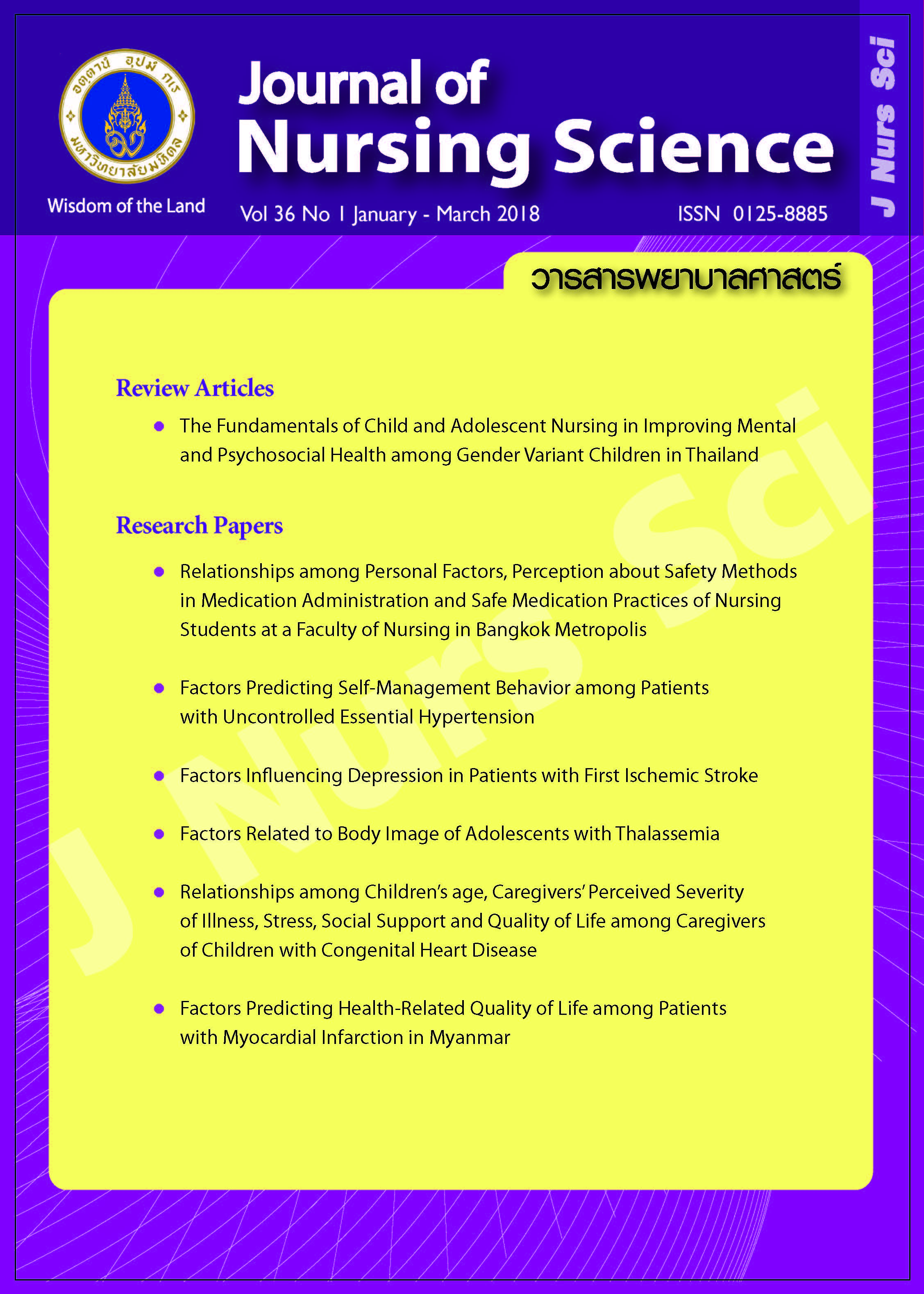ความสัมพันธ์ระหว่างปัจจัยส่วนบุคคล การรับรู้เกี่ยวกับวิธีการให้ยาอย่างปลอดภัย กับการปฏิบัติการให้ยาอย่างปลอดภัยของนักศึกษาพยาบาลในสถาบันการศึกษาพยาบาลแห่งหนึ่งในกรุงเทพมหานคร
Main Article Content
บทคัดย่อ
วัตถุประสงค์: เพื่อศึกษาความสัมพันธ์ระหว่างปัจจัยส่วนบุคคล การรับรู้เกี่ยวกับวิธีการให้ยาอย่างปลอดภัย
กับการปฏิบัติการให้ยาอย่างปลอดภัยของนักศึกษาพยาบาล
รูปแบบการวิจัย: การศึกษาความสัมพันธ์เชิงบรรยาย
วิธีดำเนินการวิจัย: กลุ่มตัวอย่างเป็นนักศึกษาพยาบาลจำนวน 420 คน ของคณะพยาบาลศาสตร์แห่งหนึ่ง
ในกรุงเทพมหานคร ซึ่งมีประสบการณ์การให้ยามากกว่า 5 ครั้ง ตอบแบบสอบถาม 3 ชุด: ข้อมูลส่วนบุคคล การปฏิบัติการให้ยาอย่างปลอดภัย และการรับรู้เกี่ยวกับวิธีการให้ยาอย่างปลอดภัย วิเคราะห์ข้อมูลโดยใช้สถิติเชิงพรรณา และวิเคราะห์ความสัมพันธ์โดยใช้ค่าสัมประสิทธิ์สหสัมพันธ์เพียร์สัน
ผลการวิจัย: นักศึกษาพยาบาล 420 คนมีอายุเฉลี่ย 21.62 ปี (SD = 1.15) ผลการวิจัยพบว่า ร้อยละ 97.4
ของนักศึกษาพยาบาลมีการรับรู้ความสำคัญ/ความจำเป็นเกี่ยวกับวิธีการให้ยาอย่างปลอดภัยอยู่ในระดับสูงถึงสูงมาก ร้อยละ 73.6 มีการปฏิบัติการให้ยาอย่างปลอดภัยอยู่ในระดับเสี่ยงน้อยมาก การรับรู้เกี่ยวกับวิธีการให้ยาอย่าง
ปลอดภัย (r = .464) การเตรียมความรู้เรื่องยามาก่อน (r = .358) การตระหนักถึงความปลอดภัยของผู้ป่วย (r = .302) การฝึกทักษะด้วยตนเอง (r = .238) การรับรู้ความสำคัญของตนเอง (r = .181) และ อายุ (r = .153) มีความสัมพันธ์เชิงบวกกับการปฏิบัติการให้ยาอย่างปลอดภัยอย่างมีนัยสำคัญทางสถิติที่ .05
สรุปและข้อเสนอแนะ: การรับรู้เกี่ยวกับวิธีการให้ยาอย่างปลอดภัย การเตรียมความรู้เรื่องยามาก่อน การตระหนักถึงความปลอดภัยของผู้ป่วย การฝึกทักษะด้วยตนเอง และการรับรู้ความสำคัญของตนเองเป็นปัจจัยที่สำคัญต่อการปฏิบัติการให้ยาอย่างปลอดภัยของนักศึกษาพยาบาล ครูควรติดตามประเมินการรับรู้เกี่ยวกับวิธีการให้ยาอย่างปลอดภัย และกระตุ้นส่งเสริมให้นักศึกษามีการเตรียมความรู้เกี่ยวกับยาและฝึกทักษะด้วยตนเองมาก่อนเพื่อเพิ่มความรู้ ประสบการณ์ และทักษะในการให้ยาอย่างปลอดภัย ยิ่งกว่านั้นครูจำเป็นต้องเน้นให้นักศึกษาตระหนักถึงความปลอดภัยของผู้ป่วย และความสำคัญของนักศึกษาในกระบวนการให้ยาอย่างปลอดภัย เพื่อพัฒนาการปฏิบัติการให้ยาอย่างปลอดภัย และลดความเสี่ยงในการเกิดความคลาดเคลื่อนทางยาได้
Article Details
ลิขสิทธิ์: วารสารพยาบาลศาสตร์เป็นเจ้าของลิขสิทธิ์ในการเผยแพร่ผลงานที่ตีพิมพ์ ห้ามผู้ใดนำบทความที่ได้รับการตีพิมพ์ในวารสารพยาบาลศาสตร์ไปเผยแพร่ในลักษณะต่างๆ ดังต่อไปนี้ การส่งบทความไปตีพิมพ์เผยแพร่ที่อื่น การนำบทความเผยแพร่ออนไลน์ การถ่ายเอกสารบทความเพื่อกิจกรรมที่ไม่ใช่การเรียนการสอน ยกเว้นเสียแต่ได้รับอนุญาตจากวารสารพยาบาลศาสตร์

Disclaimer: เนื้อหาบทความหรือข้อคิดเห็นใดๆ ในวารสารพยาบาลศาสตร์ ถือเป็นความรับผิดชอบของผู้เขียน กองบรรณาธิการไม่จำเป็นต้องเห็นด้วยและไม่มีส่วนรับผิดชอบแต่อย่างใด
References
mediacentre/news/releases/2017/medication-related-errors.
2. Hicks RW, Becker SC, Windle PE, Krenzischek DA. Medication errors in the PACU. J Perianesth Nurs. 2007;22(6):413-9.
3. National Patient Safety Agency. Safety in doses: improving the use of medicines in the NHS (published 2009) [Internet]. London: National Reporting and Learning Service (NRLS); 2009 [cited 2017 Mar 31]. Available from: http://www.nrls.npsa.nhs.uk/resources/?entryid45=61625.
4. Morimoto T, Sakuma M, Matsui K, Kuramoto N, Toshiro J, Murakami J, et al. Incidence of adverse drug events and medication errors in Japan: the JADE study. J Gen Inter Med. 2011;26(2):148-53.
5. Lanzillotti Lda S, de Seta MH, de Andrade CL, Mendes Junior WV. Adverse events and other incidents in neonatal intensive care units. Cien Saude Colet. 2015;20(3):937-46.
6. Seys D, Wu AW, Van Gerven E, Vleugels A, Euwema M, Panella M, et al. Health care professionals as second victims after adverse events: a systematic review. Eval Health Prof. 2013;36(2):135-62.
7. Cousins DH, Gerrett D, Warner B. A review of medication incidents reported to the National Reporting and Learning System in England and Wales over 6 years (2005-2010). Br J Clin Pharmacol. 2012;74(4):597-604.
8. Alsulami Z, Conroy S, Choonara I. Medication errors in the Middle East countries: a systematic review of the literature. Euro J Clin Pharmacol. 2013;69(4):995-1008.
9. Mansouri A, Ahmadvand A, Hadjibabaie M, Kargar M, Javadi M, Gholami K. Types and severity of medication errors in Iran: a review of the current literature. Daru. 2013;21(1):49.
10. Wolf ZB, Hicks RJF, Serembus JF. Characteristics of madication errors made by students during the administration phase: a descriptive study. J Prof Nurs. 2006;22(1):39-51.
11. National Coordinating Council for Medication Error Reporting and Prevention. What is a medication error? [Internet]. Rockville, MD: NCCMERP; 2001 [cited 2014 Dec 21]. Available from: http://www.
nccmerp.org/about-medication-errors.
12. Institute for Safe Medication Practices (ISMP). Error-prone conditions that lead to student nurse-related errors [Internet]. Horsham, PA: ISMP; 2007 [cited 2014 Dec 22] Available from: http://www.ismp’org/newsletters/acutecare/articles/20071018.asp.
13. Valdez LP, de Guzman A, Escolar-Chua R. A structural equation modeling of the factors affecting student nurses’ medication errors. Nurse Educ Today. 2013;33(3):222-8.
14. Ningsanon T. Medication administration for patient safety. 3rd ed. Bangkok: Hospital Pharmacy Association; 2011. (in Thai).
15. Elliott M, Liu Y. The nine rights of medication administration: an overview. Br J Nurs. 2010;19(5):300-5.
16. Apinan. Theory of perception [Internet]. 2012 [cited 2014 Dec 1]. Available from: http://finearts.exteen.com/20121109/entry. (in Thai).
17. Mayo AM, Duncan D. Nurse perceptions of medication errors: what we need to know for patient safety. J Nurs Care Qual. 2004;19(3):209-17.
18. Sulosaari V, Kajander S, Hup IM, Huupponen R, Leino-Kilpi H. Nurses students’ medication competence--an integrative review of the associated factors. Nurse Educ Today. 2012;32(4):399-405.
19. Aggar C, Dawson S. Evaluation of student nurses’ perception of preparedness for oral medication administration in clinical practice: a collaborative study. Nurse Educ Today. 2014;34(6):899-903.
20. Vaismoradi M, Jordan S, Turunen H, Bondas T. Nursing students’ perspectives of cause of medication errors. Nurse Educ Today. 2014;34(3):434-40.
21. Valdez LP, de Guzman Aduc, Escolar-Chua RA. Structural equation modeling of the factors
affecting student nurses’ medication errors. Nurse Educ Today. 2013;33(3):222-8.
22. Krauscheid LC, Orton VJ, Chorpenning L, Ryerson R. Student nurse perceptions of effective medication administration education. International Journal of Nursing Education Scholarship. 2011;8(1). doi: 10.2202/1548-923X.2178.
23. National Statistical Service. Sample size calculator [Internet]. Belconnen, Australia: National Statistical Service; 2008. Available from: http://www.nss.gov.au/nss/home.nsf/pagesSample+size+calculator.
24. Wright K. An exploration into the most effective way to teach drug calculation skills to nursing students. Nurse Educ Today. 2005;25(6):430-36.
25. Page K, McKinney AA. Addressing medication errors – The role of undergraduate nurse education.
Nurse Educ Today. 2007;27(3):219-24.

